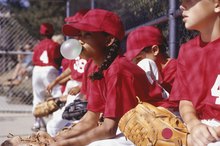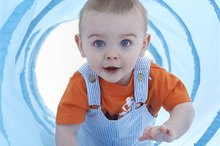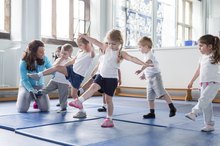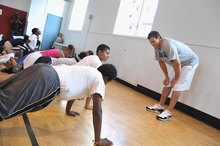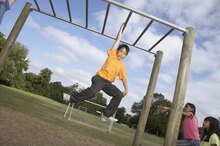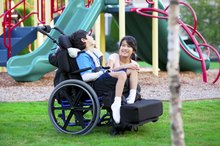**With the competitive nature of children's athletics, parents are starting to train and condition their children at earlier ages.
While conditioning for kids is important for athletic performance, it is essential to make sure these junior athletes receive safe, proper instruction to prevent injury and ensure proper mechanics for growing bodies. ** Knowing how to approach a properly designed program for your child is essential.
Physical Activity Versus Physical Education
Before beginning your child in a training program, learn the difference between physical activity and physical education because both are important to include 1. According to the National Association for Sport and Physical Education, physical activity is any type of bodily movement. Activities include movements such as jumping rope, raking leaves and playing on the playground.
The NASPE recommends that your child participates in 60 minutes per day of physical activity that raises the heart rate and causes heavier breathing.
Physical education is specifically designed to provide learning opportunities, appropriate instruction, and meaningful, challenging activities for children. The NASPE recommends elementary-aged children participate in 150 minutes and middle/high school children participate in 225 minutes of instructional education per week.
- Before beginning your child in a training program, learn the difference between physical activity and physical education because both are important to include 1.
- The NASPE recommends that your child participates in 60 minutes per day of physical activity that raises the heart rate and causes heavier breathing.
Age-Appropriate Activities
What Are the Health Benefits of Playing Youth Sports?
Learn More
Children need to participate in activities that will enhance their performance based upon their age level. Your child needs a program that will prevent injury and promise the proper mechanics their growing body needs. Improperly designed programs and programs that are too mature for the younger age groups can inhibit future athletic performance. For children age 2 to 5, focus on activities such as running, climbing, dancing and kicking. **Children ages 6 to 7 have more coordination and a longer attention span.
** This age group should begin the use of programs with organization such as soccer, swimming and martial arts. As children progress beyond the age of 8 most any sport is appropriate and a slow introduction into training can begin.
- Children need to participate in activities that will enhance their performance based upon their age level.
- Improperly designed programs and programs that are too mature for the younger age groups can inhibit future athletic performance.
Benefits of an Athletic Training Program
Kids benefit from a training program in many ways. The health benefits include a reduced risk of becoming overweight and getting diabetes, an improved academic performance, a higher self-esteem, and a decreased risk of depression and anxiety. Performance benefits include better coordination and balance, proper muscle movement and function, and more stamina and speed. Training with proper instruction will allow kids to participate in activities with meaningful content that help develop cognitive concepts about motor skill and fitness.
- Kids benefit from a training program in many ways.
- Performance benefits include better coordination and balance, proper muscle movement and function, and more stamina and speed.
Should My Child Participate in Strength Training Programs?
Activities to Promote Perceptual & Motor Skills
Learn More
Children can incorporate strength training into their athletic training program. Properly designed and performed strength training programs provide many benefits to young athletes 1. Growing athletes need to use exercises that use their own body weight or resistance tubing. Small weights are also acceptable.
A kid's strength-training program will include exercises to increase strength and endurance, protect from injury and improve performance, not build muscle size 1. When starting a strength training program seek quality instruction first. Find a personal trainer or coach who understands the limits of a developing body and can design a program around a specific kid's age, size, skill and sports interest.
- Children can incorporate strength training into their athletic training program.
- A kid's strength-training program will include exercises to increase strength and endurance, protect from injury and improve performance, not build muscle size 1.
What Should the Training Program Incorporate?
**There are many elements in a comprehensive training program.
** Proper stretching and flexibility exercises will lengthen muscles and increase the range of motion of the joints. All muscles in the legs, torso and arms need to be stretched. Cardiorespiratory exercises that raise the heart rate and increase breathing rate will improve endurance and stamina. Exercises such as running, cycling and swimming help achieve this.
Activities that incorporate agility and coordination, such as ladder drills, enhance joint proprioception to give children a sense of body position. Your child will also benefit from unstructured, free play activities that utilize self-creativity. It is essential to provide rest days in every training program. Rest days allow muscles to repair and rebuild after becoming torn down during exercise.
- There are many elements in a comprehensive training program.
- Proper stretching and flexibility exercises will lengthen muscles and increase the range of motion of the joints.
Related Articles
References
Writer Bio
Tina Hatcher began writing articles for eHow and LIVESTRONG.com in 2010. Her fitness company specializes in weight loss, sports conditioning, and kids fitness. She holds a Bachelor of Science degree in exercise science and a Master of Science degree in cardiac rehabilitation and adult fitness, both from Virginia Tech.
